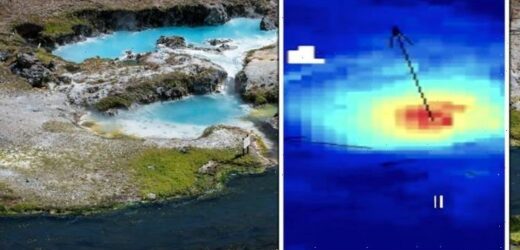Long Valley supervolcano: Geologists wonder if it's 'waking up'
We use your sign-up to provide content in ways you’ve consented to and to improve our understanding of you. This may include adverts from us and 3rd parties based on our understanding. You can unsubscribe at any time. More info
Long Valley Caldera is a depression in eastern California that sits next to the Mammoth Mountain. One of the planet’s largest calderas — a huge, cauldron-like hollow that forms after an eruption — it measures a staggering 20 miles long and 11 miles wide, and is up to 3,000 feet deep. It was originally formed 760,000 years ago when a devastating eruption released hot ash that later cooled and formed the Bishop tuff, a welded tuff that characterises the region.
Ash was sent eight miles into the air, with deposits believed to fall as far east as Kansas.
Despite the absolute chaos that Long Valley could cause if it were to erupt, little is said of it.
More attention is placed on Yellowstone, another supervolcano hundreds of miles to the north east.
Yet, according to the Science Channel, Long Valley could well be on its way to erupting.


The supervolcano and its recent activity was explored during the channel’s 2017 documentary, ‘Secrets of the Underground’.
Rob Nelson, a scientist and the show’s narrator, said: “There are alarming signs of possible volcanic activity.
“And there are clues pointing towards an imminent eruption scattered throughout this valley — the site of the second largest explosive volcanic eruption in North America.”
Even if a modern-day eruption from Long Valley was not on the same scale as previous events, it still poses an “existential threat” to the millions who live around it.
An investigation carried out by the Science Channel in a part of the valley found several instances of smoke billowing out from beneath the ground.
Jared Peacock, a geophysicist, also pointed out an alarming feature of the caldera that could spell trouble using InSAR data that has monitored the region for the last 20 years.
InSAR is a remote sensing technology which focuses a beam of radiation on a target, which then bounces back to a sensor on an antenna, creating a detailed map of a region.
JUST IN: Man discovered more valuable rock than gold

One of the most troubling areas InSAR pinpointed happened to be very close to Mammoth Lakes, a town in the Sierra Nevada mountains.
Pointing to a map created from the data, Mr Peacock said: “Right here in the middle, you see there’s a resurgent dome.”
A baking-hot red point is pictured located directly beneath the ground, where magma likely resides.
Mr Peacock added: “Something underneath it is pushing it upwards.”
In order to determine whether the Long Valley Caldera was truly coming back to life, Mr Peacock and Mr Nelson set up a pair of sensor pipes directly above the point that the InSAR data identified the resurgent dome, and scanned for signs of trouble deep underground.
DON’T MISS
Putin’s plot ‘dead in water’ a Germany slams breaks on gas [REPORT]
Archaeology breakthrough: 13-year-old makes 1300BC hoard discovery [INSIGHT]
Brexit Britain ‘to lead Europe’ with new revolutionary project [ANALYSIS]


The pipes helped detect changes in the Earth’s magnetic field, enabling the two scientists to determine whether any liquid was underground.
Running the tests, they discovered massive amounts of liquid beneath the domes’ surface: clear signs of volcanic activity.
But this activity was not centralised, which would be cause for concern.
Rather, it was sparse and spread out.
Mr Peacock said: “We can say conclusively that there is no giant magma chamber below.
“But there are smaller satellite ones around the area.”

But the danger of an eruption was not completely ruled out.
A year later, and a study published in the science journal, GeoScienceWorld, found evidence of ground deformation at the supervolcano.
Geologists who led the study found “ongoing uplift suggests new magma may have intruded into the reservoir” since at least 1978.
The uplift could be evidence of moving molten rock or the crystallisation of material deep beneath the ground.

The study reads: “Despite 40 years of diverse investigations, the presence of large volumes of melt in Long Valley’s magma reservoir remain unresolved.”
The scientists estimated the Long Valley Caldera reservoir contains “considerable qualities of melt”, likely greater than 240 cubic miles (1,000 cubic kilometres).
About 27 percent of this melt could be hot enough to be scorching liquid rock.
According to the United States Geological Survey (USGS), Long Valley last erupted about 100,000 years ago.
Source: Read Full Article


